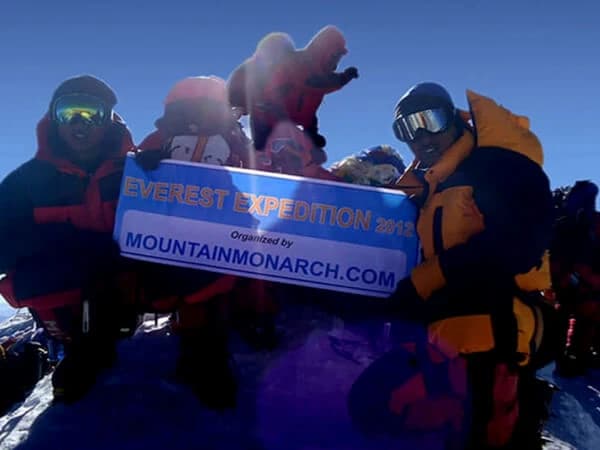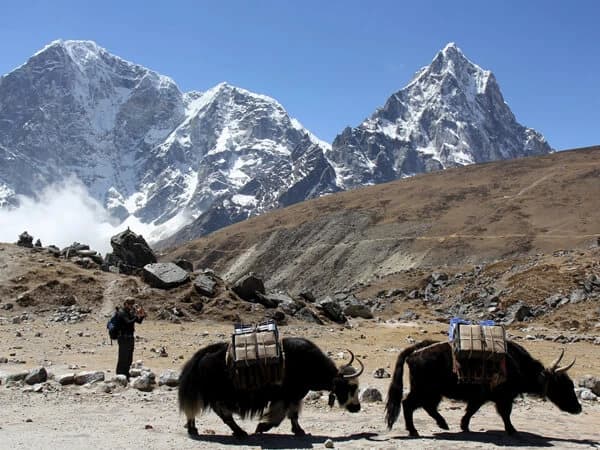Why is health and safety important on the Everest Trek?
For a more successful and smoother Everest trekking experience, adventurers must understand the significance of staying healthy, as no matter how prepared you are for the journey mentally and physically, if you are not healthy, you may have to abort in between or even before the Himalayan odyssey officially departs. The journey in general reaches high altitudes above 5,000 m, i.e., Everest Base Camp (5,364m) and a side trip to Kala Patthar (around 5,644m). For several days to a week, individuals walk 5-7 hours daily in and around the remote valleys of the Sagarmatha National Park, one of the UNESCO World Heritage Sites in Nepal, where medical facilities and other amenities are limited.
Weather can change rapidly, precisely with an increase in altitude, while the rugged terrain is one of the features of the Everest trekking routes, all of which pose serious risks of altitude sickness that further can lead to life-threatening conditions like high-altitude pulmonary edema (HAPE) and high-altitude cerebral edema (HACE) if not taken care of in time. Steep ascents and descents mean that physical exertion is normal. Therefore, ensuring health and safety with proper precautions, such as eating healthy, ample acclimatization, hydration, and correct gear, is a must for a more enjoyable, eco-friendly, and successful journey for everyone. Follow the given health precautions to Everest Base Camp, even before the beginning of the trek, while in Kathmandu as well.
What can you do while in Kathmandu to stay healthy for the trek to Everest?
Before the Everest Trek, while in Kathmandu, avoiding the uncooked meals, such as salads including lettuce, tomatoes, cucumbers, or carrots, is good so that you do not experience any stomach problems. It is the same with not drinking the water from the tap, eating only freshly cooked meals from reputable hotels and resorts, and avoiding street food as much as possible. While you are in the city, crossing roads can be a hassle, so follow locals, and in addition, ignore the street hawkers who may compel you to purchase things you do not need or wish to buy. Get plenty of rest so you can keep yourself energized and acclimatized to the local environment for the upcoming Everest journeys.
How to Fuel Your Body Right for the Everest Base Camp Trek: Hydration and nutrition for the Everest trek
The Everest treks in Nepal are high-altitude Himalayan trips where the air gets drier as you move higher and higher, and trekkers and climbers lose more fluids. Therefore, one of the Health Tips for Trekking to Everest Base Camp is to stay hydrated and refueled. While you are on the trail, remember to drink at least 3-4 liters per day, but only properly boiled and filtered water that is refillable in teahouses, lodges, and guesthouses along the Everest Trek routes at some additional cost. Consider buying a quality steel water bottle in Kathmandu, followed by iodine tablets to purify the water and make it drinkable. While you may find plastic bottled water, it is not recommended due to environmental concerns. In addition, though caffeine and alcohol are also liquids, both of these can cause dehydration, so it is best to avoid them.
Every day, trekkers and climbers during the Everest Journeys burn 3,000-6,000 calories a day; hence, the right fueling is to include meals high in carbohydrates and proteins to stay healthy for the trek to Everest Base Camp. While the Everest trekking regions offer you a wide range of menus at the teahouses, lodges, and guesthouses run by local families, it is good to go vegetarian. Usually, the meat items are carried up from lower regions and often might have been stored for a long time. Other than meat products, spicy, oily, and tinned foods are also not recommended. Remember, a balanced diet is key, which is a mix of carbs, protein, and fats.
Though very common due to below-freezing-point temperatures in the higher Himalayas, trekkers tend to skip hand washing, also due to the unavailability of water. One must not do that. Before and after eating or using bathrooms, washing hands is a must, or at the very least, you could get enough wet tissue paper. Some sections on the trek might be dusty due to yak trains and porters' parades; hence, we suggest you also get a face mask as one of the essential safety tips for trekking Everest. Keep yourself well fed. Carry high-energy chocolate bars for a quick snack break, also instant soup or nuts, and remember to rehydrate yourself time and again.
Must you get trekking poles for the trek to Everest Base Camp?
It is because the Everest Trek, including the Everest Base Camp Trek, means walking through a variety of terrain, from well-established trails to rugged and uneven paths. Everest trekking safety means packing appropriate gear and clothing in layers. For the right equipment and gear for Everest high-altitude trekking safety, consider including a base layer, an insulating layer, and an outer shell in clothing. Sturdy and broken-in trekking boots with good ankle support as footwear are a must. Pairs of thin and thick socks, gloves, breathable underwear, a warm hat, sunglasses, and sunscreen are other must-haves in your 30-40 L backpack. In addition to first aid kits, personal medications (if any), and toilet paper are to maintain your hygiene and sanitation.
Trekking poles are one instance of the many pieces of equipment mountaineers and trekkers should pack to ensure Everest Base Camp Hiking Health and Safety, to avoid mishaps and injuries during the true Everest expeditions. The poles give you stability and the ability to balance yourself, especially while going on steep ascents and descents. The trekking poles that are adjustable as per your height and the nature of the trekking trail keep you upright, while knee caving lessens the strain placed by loaded backpacks. To put it simply, trekking poles significantly enhance stability and improve balance, which helps a lot to reduce the chances of accidents on Everest journeys and ensures a more secure and comfortable trip.
Why is it important to choose the best trekking company for Everest Base Camp Hiking Health and Safety?
While several trekking companies in Nepal offer packages to reach the Everest Base Camp and other landmarks of the Everest Trekking Region, one of the health tips for trekking to Everest Base Camp is to always opt for the best company and itinerary—those that allow ample time for exploration and acclimatization and companies that have safety backup like cylinder/medical support with experienced medical high-altitude-trained guides, such as Mountain Monarch. In addition, we also provide an extra sleeping bag and other gear if needed, all covered under the comprehensive package. All our curated itineraries complete the Everest Base Camp Treks side by side and monitor your daily health. In need, we also arrange emergency evacuations, other to managing logistics efficiently.
Where to stay for Everest high-altitude trekking safety?
Tea houses, lodges, and guest houses are the common forms of accommodation during Everest treks. Usually, these places are run by local families and provide you with a room featuring a twin bed, simple bedding, shared bathrooms, and toilets outside of the teahouse. Though you may find larger and private rooms in larger Sherpa villages like Namche Bazaar, Tengboche, Dingboche, and Lobuche at some extra cost, it is better to opt for a twin-bedded room on a trek. Sometimes, a few trekkers suffer from choking at night due to the elevation. Though it is a normal occurrence and not dangerous, it still can be a frightening experience, where having a roommate makes things a lot easier, including during any other health-related issues on the trek. As your guide and sherpa also stay at the same teahouse throughout the Everest journey, you will be assisted 24/7.
Health and safety precautions Everest Base Camp: Avoid Altitude sickness on the Everest Trekking Trail
Altitude sickness, or acute mountain sickness (AMS), is a natural phenomenon that occurs at high altitude when your body struggles to adapt to low oxygen levels. With some preparedness, you can prevent altitude sickness on the Everest Base Camp trek, which can be concerning for anyone, whether you are a novice or seasoned trekker; hence, the following are the essential safety tips for trekking to Everest to avoid altitude sickness on the Everest trek. High Altitude Cerebral Edema (HACE) or High Altitude Pulmonary Edema (HAPE) are severe cases and can be life-threatening if not taken care of on time, so treating altitude sickness on the Everest Trek is a must. Do not ignore the symptoms, and always opt to travel with local guides to make the right decisions for you!
- Walk slowly and steadily, following the guideline of altitude, not climbing more than 400m in a day above 3,000m, i.e., “climb high, sleep low.
- On ascents, take short steps to avoid fatigue, especially when climbing up the stairs and sloping terrains. You may want to follow the porter steps to save energy with small steps. However, while descending, it is good to keep up with your pace, and some of them are used to walking downhill with longer steps, and you may be over-exhausted.
- While descending, do it with extra precautions so you do not have to deal with knee and ankle issues.
- Always give way to yak trains or porter parades. Keep yourself on the mountainside and avoid standing in ridges.
- Give way to yak trains and groups of porters carrying heavy loads at first.
- Keep yourself hydrated and refueled. You can add ginger and garlic soup, which has proven beneficial for treating altitude sickness on the Everest Trek as a natural remedy.
- In case you see any symptoms descend immediately, or stop ascending, take some time to get used to the altitude, and then only decide what to do next by listening to your body.
- Carrying Diamox or acetazolamide after consulting with a doctor is also a good idea, etc.
Weather safety on the Everest trek: When is the best time to go for Everest Base Camp hiking in Nepal?
It is no secret that the weather in the Himalayas is unpredictable. It may rain in a while, though it was sunny a minute before, especially in the higher altitudes. Trails can get snowy, and temperatures can drop below freezing point; hence, weather safety on the Everest Trek is paramount. If you are a beginner, we advise you to embark on the Everest Base Camp trekking routes and others in the optimal time of the year, called spring and autumn. Spanning from March to May and September to November, respectively, these seasons bring the stable Himalayan weather, clear skies, excellent visibility, and moderate temperatures. Spring specifically is famous for the vibrant bloom of rhododendron and other wildflowers along the Everest Trekking Trail. Meanwhile, it usually coincides with two of the major Nepalese festivals: Dashain and Tihar. Autumn is for experiencing, seeing, and immersing yourself in local culture and traditions.
Travel insurance, guides, and porters for emergency planning, safety, and support during the Everest Trek
Travel insurance, though not mandatory, is for peace of mind while you are in one of the high-altitude trekking regions of Nepal, which comes with inherent risk to make the journey to Everest an achievement of a lifetime. So, get comprehensive travel insurance with high-altitude coverage, including emergency evacuation, medical support, trip delays or cancellation, and loss or theft of personal luggage and gear. Similarly, hiring a local guide and porter means added safety and support. A knowledgeable guide not only offers you insights into terrain and cultures and leads the tough navigations for you, but they also make sure you are healthy, fit, and well supported throughout the journey.
Porters ease your physical burden of having to carry heavy backpacks for a more enhanced Everest trekking experience. Hence, a must-not-miss Health and Safety Tips for Trek to Everest Base Camp is to always get travel insurance and hire local guides and porters. Contact us and book the Everest Trek now with Mountain Monarch. We provide altitude-trained guides and one porter per trekker for better Everest high-altitude trekking safety!
Conclusion
Staying healthy and safe during the Everest Base Camp Trek requires an understanding of the risks, preparation, and implementation of proven safety practices, which include gradual ascent, hydration, nutrition, and proper gearing, as discussed above, applicable to most high-altitude trekking safety. At Mountain Monarch, Everest Trekking, safety always comes first, and we advise you to follow the given healthy tips for trekking to Everest Base Camp and enjoy one of the world’s most iconic trekking and climbing destinations. Avoid altitude sickness and accidents on Everest journeys with this blog, or contact us, as Everest high-altitude trekking safety is our area of expertise, and we are offering discounts on Everest Trek costs, including for 2026 and 2027!





